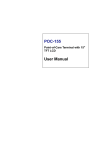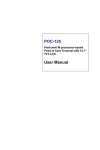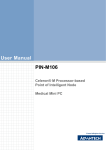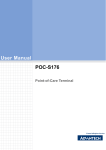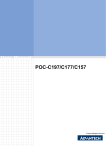Download Advantech POC-195 User`s manual
Transcript
POC- 195 Pentium® M processor-based Point of Care Terminal with 19” TFT LCD User’s Manual FCC Class B This equipment has been tested and found to comply with the limits for a Class B digital device, pursuant to Part 15 of the FCC Rules. These limits are designed to provide reasonable protection against harmful interference when the equipment is operated in a residential environment. This equipment generates, uses and can radiate radio frequency energy. If not installed and used in accordance with this user's manual, it may cause harmful interference to radio communications. Note that even when this equipment is installed and used in accordance with this user's manual, there is still no guarantee that interference will not occur. If this equipment is believed to be causing harmful interference to radio or television reception, this can be determined by turning the equipment on and off. If interference is occurring, the user is encouraged to try to correct the interference by one or more of the following measures: Reorient or relocate the receiving antenna Increase the separation between the equipment and the receiver Connect the equipment to a power outlet on a circuit different from that to which the receiver is connected Consult the dealer or an experienced radio/TV technician for help Warning Any changes or modifications made to the equipment which are not expressly approved by the relevant standards authority could void your authority to operate the equipment. Caution Danger of explosion if battery is incorrectly replaced. Replace only with the same or equivalent type recommended by the manufacturer. Dispose of used batteries according to the manufacturer’s instructions. Packing List Before installing your Point of Care Terminal, ensure that the following materials have been received: POC-195 series Point of Care Terminal User's manual Accessories for POC-195 - Y-shaped adapter for PS/2 mouse and keyboard - Power cord (1.8 m) - USA type (UK, German types are available on request) - "Drivers and Utilities" CD-ROM disc - Mounting kits and packet of screws Warning To prevent electric shock, Do not remove cover. No user serviceable parts inside, refer servicing to qualified personnel. Additional Information and Assistance 1. Visit the Advantech websites at www.advantech.com or www.advantech.com.tw where you can find the latest information about the product. 2. Contact your distributor, sales representative, or Advantech's customer service center for technical support if you need additional assistance. Please have the following information ready before you call: Product name and serial number Description of your peripheral attachments Description of your software (operating system, version, application software, etc.) A complete description of the problem The exact wording of any error messages This equipment is a source of electromagnetic waves. Before use please, make sure that there are not EMI sensitive devices in its surrounding which may malfunction therefore. Warning 1. Input voltage rated 100-240 VAC, 50-60 Hz, 4-2 A (AC Mode) 2. Use a 3 V @ 195 mA lithium battery (Model No. BR2032) 3. Packing: please carry the unit with both hands, handle with care 4. Our European representative: Advantech Europe GmbH Kolberger Straße 7 D-40599 Düsseldorf, Germany Tel: 49-211-97477350 Fax: 49-211-97477300 5. Maintenance: to properly maintain and clean the surfaces, use only approved products or clean with a dry applicator Safety Instructions 1. Read these safety instructions carefully. 2. Keep this User's Manual for later reference. 3. Disconnect this equipment from any AC outlet before cleaning. Use a damp cloth. Do not use liquid or spray detergents for cleaning. 4. For plug-in equipment, the power outlet socket must be located near the equipment and must be easily accessible. 5. Keep this equipment away from humidity. 6. Put this equipment on a reliable surface during installation. Dropping it or letting it fall may cause damage. 7. The openings on the enclosure are for air convection. Protect the equipment from overheating. DO NOT COVER THE OPENINGS. 8. Make sure the voltage of the power source is correct before connecting the equipment to the power outlet. 9. Position the power cord so that people cannot step on it. Do not place anything over the power cord. 10. All cautions and warnings on the equipment should be noted. 11. If the equipment is not used for a long time, disconnect it from the power source to avoid damage by transient overvoltage. 12. Never pour any liquid into an opening. This may cause fire or electrical shock. 13. Never open the equipment. For safety reasons, the equipment should be opened only by qualified service personnel. 14. If one of the following situations arises, get the equipment checked by service personnel: a. The power cord or plug is damaged. b. Liquid has penetrated into the equipment. c. The equipment has been exposed to moisture. d. The equipment does not work well, or you cannot get it to work according to the user's manual. e. The equipment has been dropped and damaged. f. The equipment has obvious signs of breakage. 15. DO NOT LEAVE THIS EQUIPMENT IN AN UNCONTROLLED ENVIRONMENT WHERE THE STORAGE TEMPERATURE IS BELOW -20° C (-4° F) OR ABOVE 60° C (140° F). THIS MAY DAMAGE THE EQUIPMENT. 16. If your computer is losing dramatic time or the BIOS configuration reset to default, the battery has no power. Caution 1. Do not replace battery yourself. Please contact a qualified technician or your retail. 2 .The computer is provided with a battery-powered real-time clock circuit. There is a danger of explosion if battery is incorrectly replaced. Replace only with same or equivalent type recommended by the manufacture. Discard used batteries according to the manufacturer’s instructions 17. IMPROPER INSTALLATION OF VESA MOUNTING CAN RESULT IN SERIOUS PERSONAL INJURY! VESA mount installation should be operated by professional technician, please contact the service technician or your retail if you need this service. 18. CLASSIFICATION: Supply Class I adapter No applied part IPX1 Continuous Operation Not AP or APG category 19. Disconnect device: Appliance inlet. 20. Follow the national requirement to dispose unit. 21. Maintenance: to properly maintain and clean the surfaces, use only the approved products or clean with a dry applicator. 22. Contact information: No.1, Alley 20, Lane 26, Reuiguang Road Neihu District, Taipei, Taiwan 114, R.O.C. TEL: (02)27927818 23. 24. This equipment shall not be used for life support system. 25. Accessory equipment connected to the analog and digital interfaces must be in compliance with the respective nationally harmonized IEC standards (i.e. IEC 60950 for data processing equipment, IEC 60065 for video equipment, IEC 61010-1 for laboratory equipment, and IEC 60601-1 for medical equipment.) Furthermore all configurations shall comply with the system standard IEC 60601-1-1. Everybody who connects additional equipment to the signal input part or signal output part configures a medical system, and is therefore, responsible that the system complies with the requirements of the system standard IEC 60601-1-1. The unit is for exclusive interconnection with IEC 60601-1 certified equipment in the patient environment and IEC 60XXX certified equipment outside of the patient environment. If in doubt, consult the technical services department or your local representative. 26. User not to contact SIP/SOPs and the patient at the same time. 27. The sound pressure level at the operator's position according to IEC 704-1:1982 is no more than 70dB (A). DISCLAIMER This set of instructions is given according to IEC 704-1. Advantech disclaims all responsibility for the accuracy of any statements contained herein Chapter 1General Information 1.1 Introduction The POC-195 is a multimedia Pentium® Mobile processor-based computer that is designed to serve as a Point of Care terminal (POC.) It is a PC-based system with 19" color TFT LCD display, on-board PCI express Ethernet controller, multi-COM port interfaces and 18-bit stereo audio controller. With a built-in CD-ROM drive and mini PCI expansion slot, the POC195 is as compact and user-friendly as a notebook computer. For system integrators, this simple, complete and highly integrated multimedia system lets you easily build a Point of Care Terminal into your applications. Common industrial applications include factory automation systems, precision machinery, and production process control. It is also suitable for many non-industrial applications, including interactive kiosk systems, entertainment management, and car park automation. The POC-195 is a reliable, cost-effective solution to your application's processing requirements. 1.2 Specifications General • • • • • • • Dimensions (W x H x D): 471.5 x 416.2 x 123.6 mm (18.86” x 16.64” x 4.94”) Weight: 12kg Power supply: AC model: (180 watts) Input voltage 100 - 250 VAC, 4/2 A max. @ 50 ~ 60 Hz Output voltages +5 V @ 12 A, +12 V @ 12 A, +3.3 V @ 16.8 A, +5 Vsb@ 2.0 A, -12V @ 0.8 A Cooling fan dimensions (L x W x H): CPU fan: 50 x 50 x 10mm (2" x 2" x 0.4") Disk drive housing: Space for one 2.5" HDD, one 12.7 mm Compact CD-ROM drive. Front panel: IP65/NEMA compliant Whole System: IPX1 compliant Standard PC functions • • • • • • • • • • • • • • CPU: Socket 479 Intel® Pentium® Mobile up to 2.0 GHz BIOS: Award 512 KB Flash BIOS, supports Plug & Play, APM Chipset: Intel® 915GM GMCH, 82801FBM (ICH6-M) Front side Bus: FSB 533/400MHz RAM: 240 pins DDR2 DIMM slots x 2, supports unbuffered 400/533 MHz DDR2SDRAM(Non ECC), capacity maximum to 2GB IDE interface: ATA/100 x1. Supports one IDE devices. SATA interface: SATA x1. Support one SATA device. Parallel port: Parallel port x 1, supports SPP/BPP/EPP/ECP parallel mode. Serial ports: RS232 port x 3, they are all compatible with 16C550 UARTs. COM2 has optical isolation and support RS422/RS485 by jumper selection; COM1/COM2/COM3 support +5 by jumper selection Universal serial bus (USB) port: USB2.0 port x 8 (6 external, 2 internal) IEEE 1394 port: IEEE 1394a port x 3. Expansion slot: PCI/33MHz slot x1 Watchdog timer: 62-level, interval 1 ~ 62 seconds. Automatically generates system reset when the system stops due to a program error or EMI. CMOS Battery (BIOS): 3.0 V @ 195 mA lithium battery Flat panel interface • • • • • SDVO Interface: Chrontel 7308A Single/ Dual LVDS transmitter Display resolution: Supports LVDS LCD panel resolutions up to 1600 x 900 Graphic Chipset: Intel® Graphics Media Accelerator (GMA) 900 Shared memory: Dynamic Video Memory Technology (DVMT) 3.0 to dynamically allocate up to 128 MB of system memory for graphics usage. Display type: Simultaneously supports CRT Audio function • Chipset: Realtek ALC202, compliant with AC’97 rev 2.2 • • • Audio controller: 18-bit codec, full-duplex stereo codec Audio interface: Microphone-in, Line-in, Line-out Internal Speaker: 1W speaker x 2, Full alarm volume > 70 dB(A) 1 meter Ethernet interface • • Chipset: Marvell 88E8053 PCI express high performance Gigabit Ethernet controller Ethernet interface: Gigabit Ethernet port x 2, full integrated Gigabit Ethernet Media Access Control (MAC) and Physical Layer (PHY) functions, and each provides a standard IEEE 803.3 Ethernet interface for 1000BASE-T, 100BASE-TX and 10BASET application. Optional modules • • • • • • • • CPU: Intel® Pentium® M 1.6GHz, 1.8GHz, 2.0GHz Memory: 256MB/512MB/1GB, DDR2-400/533MHz SDRAM HDD: 2.5", 40GB/60GB/80GB, 4200rpm, PATA HDD or 40GB/80GB, 5400rpm, SATA HDD Touchscreen: Analog resistive CD-ROM drive: Compact 24X CD-ROM or above COMBO drive: Compact 8X DVD-ROM, 24X CD-ROM, 24X CD-R, 24X CD-RW DVD-RW drive: Compact 8X DVD-ROM, 24X CD-ROM, 24X CD-R, 10X CD-RW, 4X DVD-RW Mini PCI WLAN module: 802.11b/g WLAN Touch screen (optional) Type Resolution Light Transmission Controller Power Consumption Software Driver Analog Resistive Continuous 75% RS-232 interface (uses COM4) +5V@200 mA Supports Windows 2000,Windows XP Durability (touches in a lifetime) 30 million Table 1.1:Touch screen specification Note The Point of Care Terminal with the optionally installed touchscreen will share COM4. Once the touch screen is installed, COM4 cannot be used for other purposes. Environment • • Temperature: 0 ~ 40°C (32 ~ 104 °F) Relative humidity: 10 °C to 40 °C / 20% RH to 90% RH operating -20 °C to 50 °C/ 10% RH to 95% RH Storage ( Non-condensing ) • Shock: 30G, half sine, 11 msec duration • Vibration: 0.047 double amplitude displacement ( 5~32Hz) 2G Peak (32 -500 Hz ) • Power MTBF: 100,000 hrs • Altitudes: Operational: 6,000 feet; Shipping : 40,000 feet • Certifications: EMC: CE, FCC approved Safety: UL60601-1 and EN60601-1 approved. This device bears the CE label in accordance with the provisions of the EMC Directive 89/336/EMC and the Low Voltage Directive 73/23/EEC. Cleaning/Disinfecting During normal use of the POC-195 may become soiled and should, therefore, be cleaned regularly. Agents: Green tinctured soap and Enzymatic detergents Steps: 1. Wipe the POC-195 with a clean cloth that has been moistened in the cleaning solution. 2. Prepare agent per manufacturer’s instructions or hospital protocol. 3. Wipe thoroughly with a clean cloth Cautions Do not immerse or rinse the POC-195 and its peripherals. If you accidentally spill liquid on the device, disconnect the unit from the power source. Contact your Biomed regarding the continued safety of the unit before placing it back in operation. Do not spray cleaning agent on the chassis. Do not use disinfectants that contain phenol. Do not autoclave or clean the POC-195 or its peripherals with strong aromatic, chlorinated, ketone, ether, or Esther solvents, sharp tools or abrasives. Never immerse electrical connectors in water or other liquids. 1.3 LCD Specifications • • • • • • • • • Display type: 19" TFT LCD. Resolution: 1280 x 1024 Colors: 16.7M (RBG8 bits/color) Dot size (mm): 0.294 x 0.294 Viewing angle: 180° Luminance: 300 cd/m2 Contrast ratio: 1300:1 LCD MTBF: 50,000 hours Backlight lifetime: 50,000 hours 1.4 Dimensions Figure 1-1: Dimensions of the POC-195 Chapter 2 System Setup 2.1 A Quick Tour of the POC-195 Before you start to set up the POC-195, take a moment to become familiar with the locations and purposes of the controls, drives, connections and ports, which are illustrated in the figures below. When you place the POC-195 upright on the desktop, its front panel appears as shown in Figure 2-1. A Power button D Touch screen B Brightness control button C Book light E Audio control button F Trim knob(optional) Figure 2-1: Front View of the Point of Care Terminal When you look at the left side of the panel PC, you will see the CD-ROM drive, two USB2.0 ports and two IEEE1394a port, as shown in Figure 2-2. Figure 2-2: Left side view of the Point of Care Terminal When you turn the Point of Care Terminal around and look at its rear cover, you will find the PCI expansion slot located on the left side. This slot is covered by a side panel cover. The sunken I/O section is at the bottom of the panel PC, as shown in Figure 2-3. (The I/O section includes various I/O ports, including serial ports, parallel port, the Ethernet ports, USB ports, the microphone jack, and so on.) A B B D E F G H I Isolated RS-232 COM port (COM1 /COM2/COM3 ) PS/2 Mouse/Keyboard Port IEEE-1394a Port Parallel Port Line-out/Line-in/MIC-in Port ( From left to right) D-sub VGA port USB 2.0 Ports RJ-45 Gigabit LAN Port Functional Earth Ground Connector Figure 2-3: Rear view of the Point of Care Terminal 2.2 Installation Procedures 2.2.1 Connecting the power cord Be sure to always handle the power cords by holding the plug ends only. Follow these procedures in order: 1. Connect the female end of the power cord to the AC inlet of the panel PC. (See Figure 2-5.) 2. Connect the 3-pin male plug of the power cord to an electrical outlet. Figure 2-5: Connecting the power cord 2.2.2 Connecting the keyboard and mouse 1. Connect the Y-shaped adapter to the PS/2 mouse and keyboard port on the I/O section of the POC-195. (See Figure 2-6.) 2. Connect the PS/2 mouse and keyboard to the Y-shaped adapter. (See Figure 2-12.) If you use a serial mouse, you can connect the mouse to any COM port in the I/O section. 2.2.3 Switching on the power Switch on the power switch on the rear cover 2.3 Running the BIOS Setup Program Your POC-195 is likely to have been properly set up and configured by your dealer prior to delivery. You may still find it necessary to use the BIOS (Basic Input-Output System) setup program to change system configuration information, such as the current date and time or your type of hard drive. The setup program is stored in read-only memory. It can be accessed either when you turn on or reset the panel PC, by pressing the " Crtl+Alt+Del " key on your keyboard immediately after powering on the computer. The settings you specify with the setup program are recorded in a special area of memory called CMOS RAM. This memory is backed up by a battery so that it will not be erased when you turn off or reset the system. Whenever you turn on the power, the system reads the settings stored in CMOS RAM and compares them to the equipment check conducted during the power on self-test (POST). If an error occurs, an error message will be displayed on screen, and you will be prompted to run the setup program. 2.4 Installing System Software Recent releases of operating systems from major vendors include setup programs which load automatically and guide you through hard disk preparation and operating system installation. The guidelines below will help you determine the steps necessary to install your operating system on the panel PC hard drive. Note Some distributors and system integrators may have already pre-installed system software prior to shipment of your panel PC. If required, insert your operating system's installation or setup diskette into the optical drive until the release button pops out. (See Figure 2-14) The BIOS supports system boot-up directly from the CD-ROM drive. You may also insert your system installation CD-ROM disk into the CD-ROM drive.. Power on or reset the system by pressing the "Ctrl"+"Alt"+"Del" keys simultaneously. The Point of Care Terminal will automatically load the operating system from the diskette or CDROM. If you are presented with the opening screen of a setup or installation program, follow the instructions on screen. The setup program will guide you through preparation of your hard drive, and installation of the operating system. 2.5 Installing the Drivers After installing your system software, you will be able to set up the Ethernet, SVGA, audio and touch screen functions. All the drivers except the CD-ROM drive driver are stored in a CDROM disc entitled "Drivers and Utilities which can be found in your accessory box. The standard procedures for installing the Ethernet, SVGA, audio and touch screen drivers are described in Chapters 3, 4, 5, 6 and 7 respectively. The utility directory includes multimedia programs. Refer to the README.TXT file inside the VGA folders for more detailed information. The various drivers and utilities in the CD-ROM disc have their own text files which help users install the drivers and understand their functions. These files are a very useful supplement to the information in this manual. For your reference, the directory of drivers on the "Drivers and Utilities" CD-ROM is: Figure 2-15: The file directory on "Drivers and Utilities" CD-ROM Note The drivers and utilities used for the POC-195 panel PCs are subject to change without notice. If in doubt, check Advantech's website or contact our application engineers for the latest information regarding drivers and utilities. Chapter 3 Graphic chipset Setup 3.1 Introduction The POC-195 has an onboard VGA interface. The specifications and features are described as follows: 3.1.1 Chipset The POC-195 uses Mobile Intel® 915GM Express chipset for its graphic controller. It supports SDVO device, and CRT monitors. The Mobile Intel® 915GM Express chipset is a component of the Intel® Centrino® mobile technology. Featuring the Intel® Graphics Media Accelerator 900, the 915GM chipset enables 2x the graphics performance of the previous generation of platforms based on the Intel® 855GME chipset. 3.1.2 Display memory Max memory allocation support based on total system memory 1-MB or 8 MB of pre-allocated memory supported. 3.1.3 LVDS Transmitter The POC-195 uses Chrontel CH7308A for driving its LCD panel. The CH7308A is a display controller device, which accepts digital graphics input signals, upscales, encodes, and transmits data through an LVDS transmitter to a LCD panel. The CH7308A operates at pixel rates of up to 140MHz, and support 18-bit/24-bit LCD panels. 3.1.4 Display types CRT and panel displays can be used simultaneously. The POC-195 can be set in one of three configurations: CRT only, LVDS only, both CRT and LFP (LVDS). The system is initially set to simultaneous display mode - CRT and LFP (BIOS default setting). Analog CRT DAC interface supports max DAC frequency up to 400 MHz, 24-bit RAMDAC, DDC2B compliant, and resolution up to 2048 x 1536. . 3.2 Installation of Graphic Driver Complete the following steps to install the SVGA driver. Follow the procedures in the flow chart that apply to the operating system that you are using within your POC-195. Important The following windows illustrations are examples only. You must follow the flow chart instructions and pay attention to the instructions which appear on your screen. Note1 The CD-ROM drive is designated as “D” throughout this chapter. Note2 <Enter> means pressing the “Enter” key on the keyboard. Note3 Before you install the graphic driver of POC-195, please ensure you have installed the “Intel Chipset Software Installation Utility”. You can find this driver in the Utility CD-ROM. Note4 The resolution of window display will be fix on 640 x 480 before you install VGA driver. Depend on your LCD native resolution, the black area might be different. 3.2.1 Installation for Windows XP Step 1-1 Click the 'Start' button in the task bar, click 'Run' and then select ' infinst_autol.exe' from the drive directory “D://Chipsetsoftware/” where the driver files are stored. The Install dialog will appear. Step 1-2 click 'Next' to continue. Step 1-3 Read License Agreement and click ‘Yes’ to proceed. Step 1-4 When the 'Setup COMPLETE' message appears click 'Finish' to restart your computer. Step 2-1 Click the 'Start' button in the task bar, click 'Run' and then select ‘Setup.exe’ from the drive directory “D://VGA/” where the driver files are stored. The Install dialog will appear. Step 2-2 click 'Next' to continue. Step 2-3 Read License Agreement and click ‘Yes’ to proceed. Step 2-4 When the 'Setup COMPLETE' message appears click 'Finish' to restart your computer. 3.3 Further information For further information about the VGA installation in your POC-195, included Driver updates, troubleshooting guides and FAQ lists please visit the following web resources. Intel website: www.intel.com.tw Advantech websites: www.advantech.com www.advantech.com.tw Chapter 4 Audio Interface 4.1 Introduction The POC-195's onboard audio interface provides high-quality stereo sound and FM music synthesis (ESFM) by using the ALC202 audio controller from Realtek. The audio interface can record, compress, and play back voice, sound, and music with a built-in mixer control. The POC-195's onboard audio interface also supports the Plug and Play (PnP) standard and provides PnP configuration for audio, FM, and MPU-104 logical devices. It is compatible with Sound Blaster, Sound Blaster Pro version 3.01, voice, and music functions. The ESFM synthesizer is register compatible with the OPL3 and has extended capabilities. 4.2 Installation of Audio Driver Before installing the audio driver, please take note of the procedures detailed below. You must know which operating system you are using in your POC-195, and then refer to the corresponding installation flow chart. Just follow the steps in the flow chart. You can quickly and successfully complete the installation, even though you are not familiar with instructions for Windows. Important The following windows illustrations are examples only. You must follow the flow chart instructions and pay attention to the instructions which appear on your screen. Note1 The CD-ROM drive is designated as “D” throughout this chapter. Note2 <Enter> means pressing the “Enter” key on the keyboard. 4.2.1 Installation for Windows 2000/XP Step 1-1 Click the 'Start' button in the task bar, click 'Run' and then select ' infinst_autol.exe' from the drive directory “D://Audio/” where the driver files are stored. The Install dialog will appear. Step 1-2 click 'Next' to continue. Step 1-3 click 'Next' to continue. Step 1-4 When the 'Setup COMPLETE' message appears click 'Finish' to restart your computer. 4.3 Further information For further information about the Audio interface installation in your POC-195, included Driver updates, troubleshooting guides and FAQ lists please visit the following web resources. Realtek website: www.realtek.com.tw Advantech websites: www.advantech.com www.advantech.com.tw Chapter 5 Touch screen Interface 5.1 Introduction 5.1.1 General Information The POC-195's optional touch screen incorporates advanced second-generation 5-wire resistive technology. They allow 75% light transmission respectively. The resistive and capacitive models have an antiglare surface. All models provide greatly enhanced visual resolution. They also have new improved scratch-resistant features. The touch screen is manufactured from UL-recognized components. When properly installed, the touch screen's ball impact resistance meets the UL 1950 standard. Its fire resistance meets the UL-746C, 19 mm (0.75") flame test standard. Systems incorporating the touch screen, controllers, and cables have been approved to FCC Class A and Class B standards. 5.1.2 General specifications Please refer to Chapter 1, Section 1.2 of this manual. 5.1.3 Environmental specifications Temperature: -0° ~ 40° C (operating) -20° ~ 60° C (storage) Relative humidity: 90 RH at 35° C (operating) 90 RH at 35° C for 240 hours, non-condensing (storage) Chemical resistance: The active area of the touch screen is resistant to the following chemicals when exposed for a period of one hour at a temperature of 21° C (71° F): - Acetone - Methylene chloride - Methyl ethyl ketone - Isopropyl alcohol - Hexane - Ammonia-based glass cleaners - Turpentine - Mineral spirits - Foods and beverages 5.2 Installation of Driver for Touch screen To facilitate installation of the touch screen driver, you should read the instructions in this section carefully before you attempt installation. Important The following windows illustrations are examples only. You must follow the flow chart instructions and pay attention to the instructions which appear on your screen. Note1 The CD-ROM drive is designated as “D” throughout this chapter. Note2 <Enter> means pressing the “Enter” key on the keyboard. 5.2.1 Installation for Windows XP Step 1-1 Click the 'Start' button in the task bar, click 'Run' and then select ' sw500930.exe' from the drive directory “D://Elotouch/” where the driver files are stored. The Install dialog will appear. Step 1-2 click 'Ok' to continue. Step 1-3 click 'Unzip' to continue. Step 1-4 click 'Ok' to continue. Step 1-5 click 'Next' to continue. Step 1-6 Read License Agreement and click ‘Yes’ to proceed. Step 1-7 click 'Next' to continue. Step 1-8 click 'Next' to continue. Step 1-9 click 'Next' to continue. Step 1-10 When the 'Setup COMPLETE' message appears click 'Finish'. And follow up the software guiding to complete touch screen calibration procedures. 5.3 Further information For further information about the Touchscreen installation in your POC-195, included Driver updates, troubleshooting guides and FAQ lists please visit the following web resources. Elo website: www.elotouch.com Advantech websites: www.advantech.com www.advantech.com.tw Chapter 6 PCI Express Ethernet Interface 6.1 Introduction The POC-195 is equipped with a high performance PCIe Ethernet chipset Marvell 88E8053 which is fully compliant with IEEE 802.3 10/100/1000 Mbps standards. The Ethernet port provides a standard RJ-45 jack. 6.2 Installation of Ethernet Driver 6.2.1 Installation for Windows XP Step 1-1 Click the 'Start' button in the task bar, click 'Run' and then select ' SetupYukonWin.exe' from the drive directory “D://LAN_Marvell/” where the driver files are stored. The Install dialog will appear. Step 1-2 click 'Next' to continue. Step 1-3 click 'Next' to continue. Step 1-4 When the 'Setup COMPLETE' message appears click 'Finish' to restart your computer. 6.3 Further information For further information about the Ethernet installation in your POC-195, included Driver updates, troubleshooting guides and FAQ lists please visit the following web resources. Marvell website: www.marvell.com Advantech websites: www.advantech.com www.advantech.com.tw




























